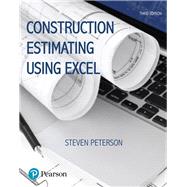For beginning to intermediate courses in construction estimating in two- and four-year construction management programs.
A step-by-step, hands-on introduction to commercial and residential estimating
Construction Estimating with Excel, 3/e, introduces readers to the fundamental principles of estimating using drawing sets, real-world exercises, and examples. The book moves step-by-step through the estimating process, discussing the art of estimating, the quantity takeoff, how to put costs to the estimate, and how to finalize the bid. As students progress through the text they are shown how Microsoft Excel can be used to improve the estimating process. Because it introduces spreadsheets as a way of increasing estimating productivity and accuracy, the book can help both beginning and experienced estimators improve their skills.
The Third Edition gives students a broader understanding of construction estimating with a new chapter discussing the role that estimating plays in different project delivery methods and in the design process and how to use data from RSMeans. To bring the book up to date, the material and equipment costs and labor rates have been updated to reflect current costs, and the discussion of Excel (including the figures) is based on Excel 2016. Additionally, content throughout the book has been updated to align to ACCE and ABET student learning outcomes. Student resources are available on the companion website www.pearsonhighered.com/careersresources/.










